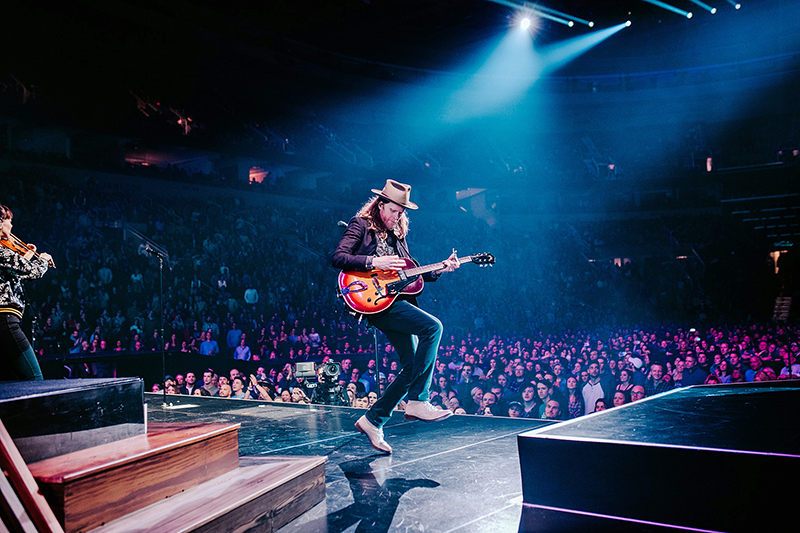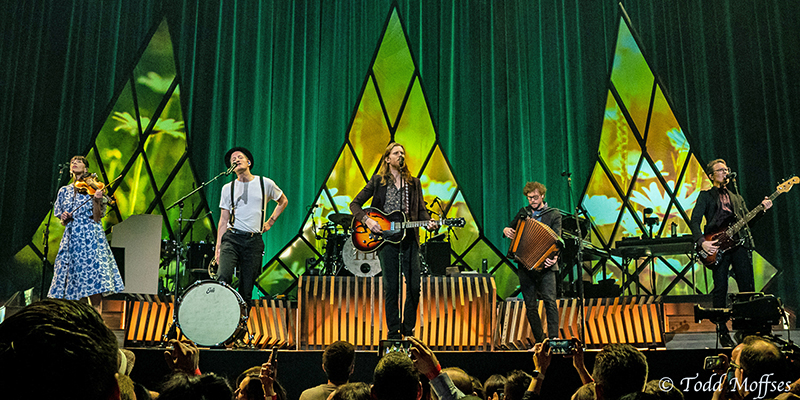
The Lumineers, a folk rock band led by founding members Wesley Schultz (lead vocals, guitar) and Jeremiah Fraites (drums, percussion, piano) since 2005, have added and subtracted various members since their self-titled debut album in 2012. The band then embarked on a second world tour in support of their second album, Cleopatra, in 2016-2017. Last fall, the band released their third studio album, named, simply, III, also accompanied by a world tour. A run of festival shows preceded the tour last summer, with the full production starting last fall, one that is expected to continue once the Covid-19 virus stands down. PLSN questioned designers Sooner Routhier and Robert Long as well as lighting director Ian Haslauer, video director David Boisvert and lead carpenter Jason Spisak.

The Overall Vision
The fictional Sparks family of the album’s storyline is caught in generations of alcohol and drug abuse. “Our focus was to create a voyeuristic feel to the set, as if the audience is watching the Sparks family through their struggles while The Lumineers set the soundtrack,” says Sooner. “Essentially, we wanted to put the band in a glass bubble or fish tank. The wooden structure that curves up and over the band as well as the frame on the circular screen resemble pieces of a geodesic structure that has cracked open. Each of these pieces is a video screen. The “sails” in the back are rear projection surfaces while the circular screen above is LED. We play pieces of the videos combined with video content created by Andy Reuter across the surfaces throughout the show. It almost feels like you’re watching the Sparks family through windows, peering into their lives as they continue the cycle of abuse.
“We further the feeling of windows upstage right and left of the band,” Sooner adds. “There are large LED walls set behind gray curtains. The curtains open much like curtains in a house to reveal the video walls. Once again, it feels as though the audience is watching the family through the windows of their home. Robert and I also wanted to give a little nod to the band’s home base of Denver, CO. Taken in as a whole, the band’s risers and the screen above feel like mountains holding up the sun.”
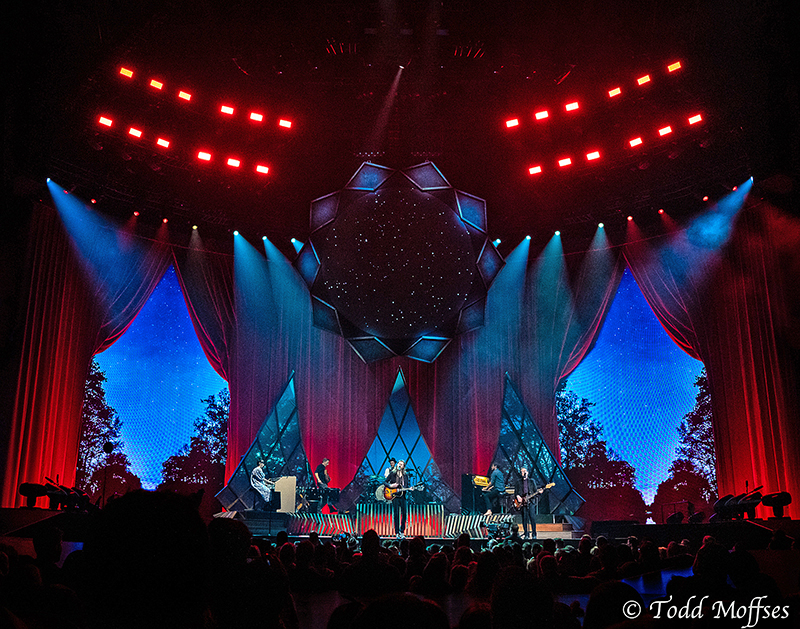
This is the second design this team has taken on for the Lumineers. The band, Sooner and Robert acted as the creative directors for this production. “The band typically allows us to run freely with creative,” Routhier notes. For this tour, she adds, “we wanted to make sure we were representing the direction of the current album cycle properly. They rolled out the album, III, in a unique way. It was released in three parts. Every song has a filmic music video attached to it. The videos create a film that tells the story of the Sparks. Our main objective was to tie the Sparks family story into the live show.”
The stage set is very elegant in its design. The simple riser setup has a custom designed fascia that is made up of metal slats that Tait has treated to look like wood, backed with some frosted Plexiglas. The wood could be front-lit, while the Plexiglas was bathed in color from behind, making the artwork stand out.
Behind the risers sits three hard structure sails, made of wood and frosted material. The sails are formed from a collection of diamond-shaped sections that are lined with LED tape as well as rear projected upon by three Barco UDX Laser 32K projectors, which sit seven feet away.
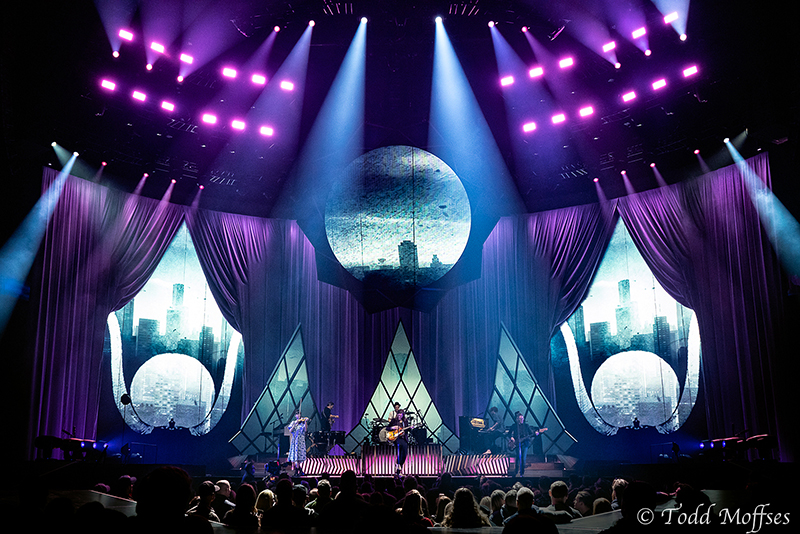
We asked Robert Long how he gets his ideas, and where this one came from. “The process for any project varies in many ways. Inspiration can come from anywhere at any time. Both doodling and different types of architecture can inspire a particular design. The Lumineers’ music inspires a certain vision. Meaning when you see a certain architectural style, you instantly know what is right for them. This particular design was specifically inspired by a small structure we found in nature.
“I brought the angles and inspiration ideas to Sooner, and she started drawing until we came up with an idea that we both liked. Once our plot was approved by the band, it was sent to Tait, where they took almost the exact design and made it applicable to a live environment.” In the end, each sail was made from four separate sections that anchored to a base plate.
Above the sails sits a circular LED wall made from Saco S6mm video tiles. A custom-built surround that plays off the diamond shapes of the sails sits in front of it, acting as a mask and resembling a sun. Head carp Jason Spisak explains, “The sun is a frame structure that breaks apart into six main pieces, which are attached to the aluminum diamonds. There is a scenically treated canvas used for the center of the diamonds. The paint is specific to gathering light.”
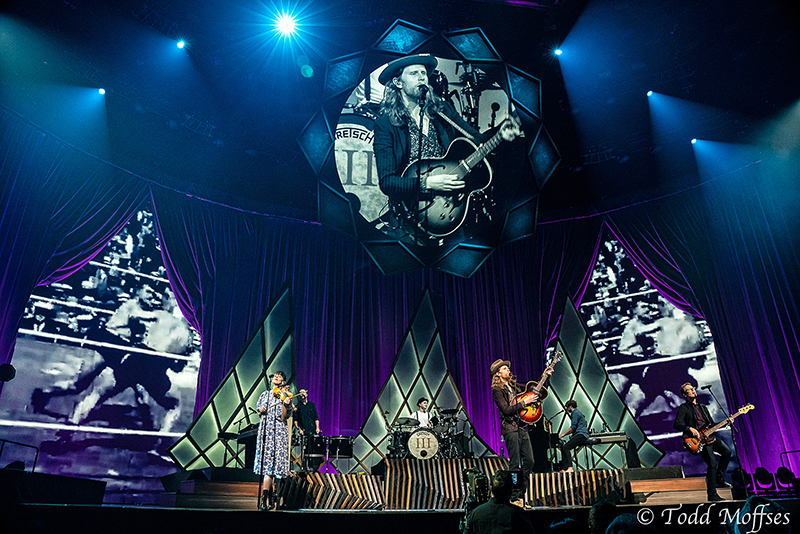
Behind the band are some glorious full drapes manufactured by Atomic Scenery. The soft goods take light well, illuminated by Chroma-Q Color Force II battens from above and below. They expand the width of the stage and are 44 feet in height. At one point in the show, the drapes split open on the SL and SR sides of the sun to reveal some 12mm Saco products, displayed in a triangular shape due to the way the drapes opened. Spisak describes how “the curtains are raised by a remote system of strings and pulleys” to achieve a look of elegance.
Lighting director Ian Haslauer explains the show flow with these pieces. “The show runs from 9 p.m. to 10:45 each night. The drapes currently open during ‘Gloria,’ which is 11 songs into the set. It is normally right after the song ‘Angela,’ where Wes wanders throughout the house with all RoboSpots aimed on him. During this song, I am not lighting the drapes at all, and they almost disappear, we forget they are there. This creates that much more energy when they open right at the top of the song.”
Bypassing a center thrust, the design team opted for a wraparound walkway into the house, with attendees in the center. Different sections of the ramp offered strategic places for the artists to play from, including a couple of lifts utilized to raise extra drum kits or upright pianos up to playing height at opportune times. Sooner explains this concept. “Wes (the lead singer of the band) was an integral part of creating the show direction. He wanted to make sure that thrust wasn’t simply a runway and a ‘B’ stage for them to perform on. He wanted those components of the stage to be as important as the main stage. There are many performance moments scattered throughout the show that utilize the downstage most stages as well as the runway that connects them.
“The show starts with a kabuki drop, so everyone’s eyes are focused on the stage,” Sooner continues. “The drum lift on SL then comes up, and the show starts, which I think catches people by surprise. Some of the transitions are quite quick, and these two lifts do an excellent job in facilitating that.”
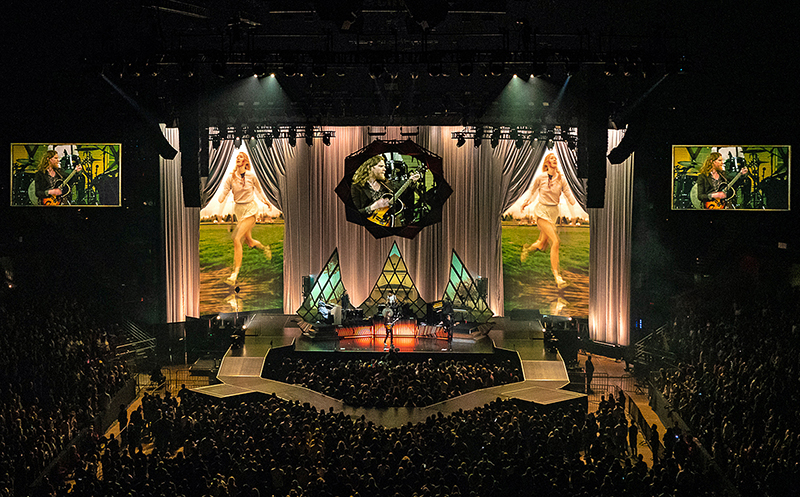
Lighting-Wise
Solotech had worked with the Lumineers before, but this was their first time providing lighting as well as the video elements. The lighting was fairly simple, with a few layers of tiered trusses that paralleled the shape of the three upstage rag trusses. The design team specifically went with one type of moving light while relying on Solaris Flares to wash the stage and house with color. Routhier explains her fixture choice. “These days, I like to choose a profile spot that has certain features that we need for the tour. I like to work with the chosen vendor to determine the best light available in their inventory to handle the specs. The Claypaky Scenius fixture is in Solotech’s inventory and met all the requirements we needed. The Flares are integral to making the under riser glow. Those are indispensable. We tried a few other fixtures in the beginning and did not get the same results.”
For most of the show, the design pairs a monochromatic lighting palette with a very clean stage. There are few mixed color schemes other than when the media and lights are in complementing colors. Sooner explains her way of lighting. “This is just my general philosophy when lighting a tour. I like to keep the color schemes simple. That way, the audience sees a cohesive vision. If there is green and red in the video content, we won’t use yellow and blue in the lighting. It’s important to remember that video is also a source of light. Once you get too many colors in the air, it becomes a brown mush. Of course, if the content is multi-colored, we will make sure to create an interesting multi-colored look. It’s just about making the overall vision cohesive.”

A three-sided front truss sits out in the middle of the house, allowing the lights mounted on it to have straight shots at the performers anywhere on stage, including the house walkway. Seven BMFL followspot fixtures run on the Robe RoboSpot system. Haslauer describes their usefulness. “The RoboSpots have been amazing. I enjoy the consistency that it brings to the show. We actually have five out on the FOH truss, and then two that have been moved to a truss onstage to act as backlights whenever the principal band members are out on the thrust. The only thing that the operators have control of is iris (and pan/tilt of course). All of the intensities are programmed into the cues but are then individually shaded by our FOH tech. They have become such an important part of the show that we are currently looking ahead to all our upcoming sheds and finding creative ways to still put the system in.”
PLSN first ran into Ian at a Lumineers show last summer. He explains the schedule they have been on. “We initially previz’d for the festival run for a week at the SRae Productions’ office in Nashville last May. Following that, we did two weeks of rehearsals in Pensacola, FL for our first show of the festival circuit at the Hangout Festival in Gulf Shores, AL. The main element from the current design that we started with were the sails, band risers and accompanying pieces that faced the front of it. Video content was added to the show on the sails throughout the festival run as new songs and their accompanying music videos were released. We also carried the drape, a hydraulic lift for a B-stage and a lighting floor package, among other things.”
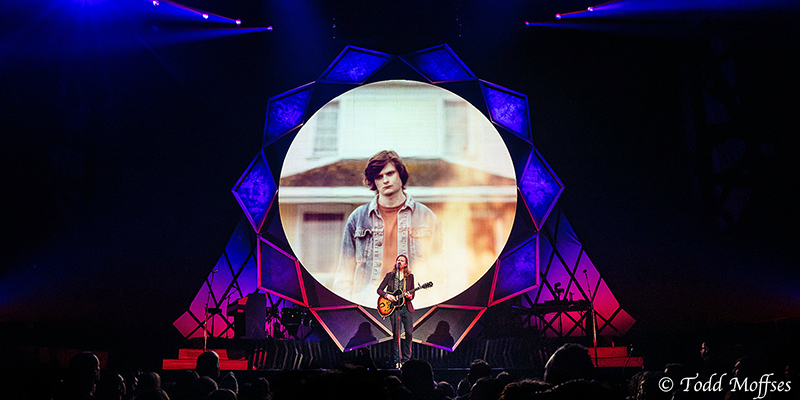
We noticed that Ian (who also programmed the lighting) has worked with Sooner on several projects. He expands on his first go directing the Lumineers show. “I couldn’t be happier to be here. The core crew has been with the camp through several album cycles, which is a good sign. Everybody in the camp deeply cares about the quality of the show and about each other.”
As far as operating the console, Ian lets us know that “the band does not play to click whatsoever, so therefore no timecode. For the last three years, I was with a band that was heavily dependent on timecode. I still approached the programming as if it were a time-coded show, which makes for busy fingers at times. I am very grateful to the whole team on Clearcom who are always paying attention so that I can actually focus on running the show.”
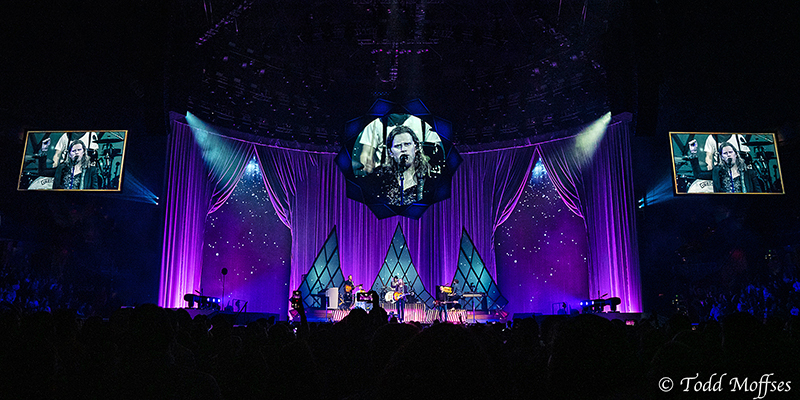
The Video Department
This is David Boisvert’s second tour with the band, serving as the video director for the 2016/2017 Cleopatra tour as well. We asked him what tools he’s relying on for this production. “I’m cutting cameras on a Grass Valley Karrera switcher. For cameras, we are utilizing four Grass Valley LDX-86 HD manually-operated cameras, three Fujinon (80x) long lenses at FOH, one Fujinon (12x) on a dolly track in the pit, three Panasonic 130 robotic cameras and two Marshall fixed cameras for drums.”
A pair of disguise gx 2 media servers feed content to the various screens. Dan Gentile is the servers engineer. He programmed them through a grandMA2, which is then triggered by Ian.
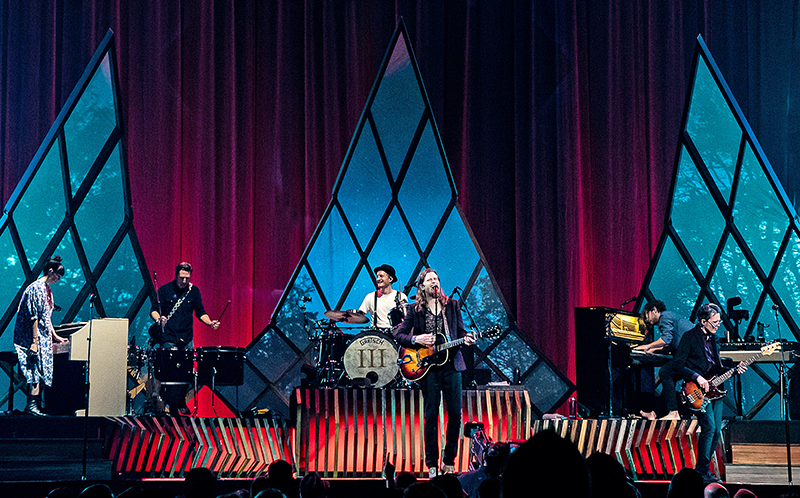
Offstage, the production featured a couple of I-Mag projection screens illuminated by four Christie 20K Roadster projectors.
Todd LePere is the Solotech rep who has continued to look after this band for several years. “In 2016, I received a call to help The Lumineers locate some video gear for their “Life Is Beautiful” festival show, headlining on a Sunday night in Las Vegas. I was able to pull together the gear and crew needed and have maintained a wonderful relationship with Sara Full and her team ever since. Come 2017, Solotech was given the opportunity to provide the video package for their Cleopatra world tour, which has now led to us providing all the video, lighting and rigging services for their current world tour, III. It has also been a pleasure to work with Robert Long and Sooner Routhier to execute their incredibly artistic and intimate designs along the way.”
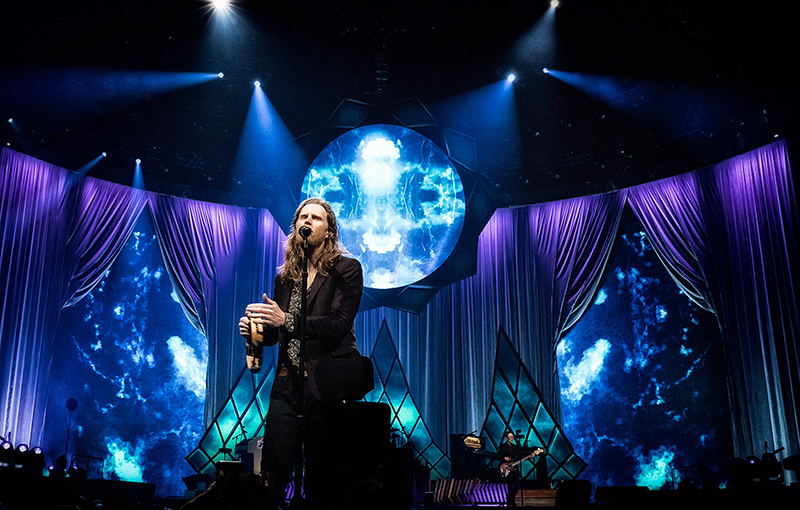
The Lumineers III Tour
Crew
- Creative/Production and Lighting Design: Sooner Routhier and Robert Long
- Tour Manager/Production Manager: Sara Full
- Stage Manager: Sam Cole
- Production Coordinator: Tessa Greiman
- Tour Accountant: Samara Goldhecht
- Assistant Tour Manager: Anthony Hook
- Security Director: Roger Stephenson
- Backstage Coordinator: Rebecca McClendon
- Head Rigger: Sebastien Beaulieu
- Riggers: Sebastien “Lobster” Valin-Lemay, Maksymilian Wrobel
- Head Carpenter: Jason Spisak
- Carps and Automation: Chase Paulino, Mike Ryder, Nick Smith, Barbara Pinnow
- Lighting Director: Ian Haslauer
- Lighting Crew Chief: Anthony Michon
- Lighting Techs: Louis-Marc Plante, Pierre Olivier “Pio” Gravel Laroque, Eric Cere, Corinna “Blue” Johnston
- Video Director: David Boisvert
- Video Engineer: Fred Fournier
- Video Crew Chief: Krystena Rice
- Media Server Tech: Dan Gentile
- LED/Camera Techs: Alex Charland, Lee Shull, Jeff Apregan, Josh Phebus
- Tour Photographer: Austin Roa
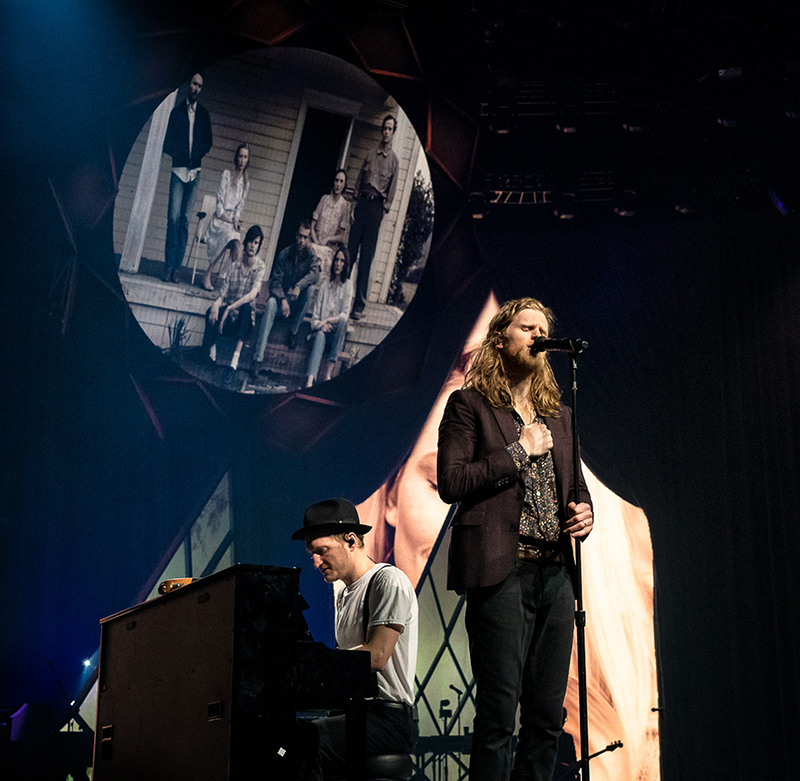
Gear
Lighting:
- 2 grandMA Full consoles
- 1 grandMA Light console
- 18 Chroma-Q Color Force II 12s
- 25 Chroma-Q Color Force II 72s
- 96 Claypaky Scenius Unicos
- 7 Robe BMFL Followspots
- 7 Robe BMFL RoboSpot controllers
- 4 MDG The One w/ fans
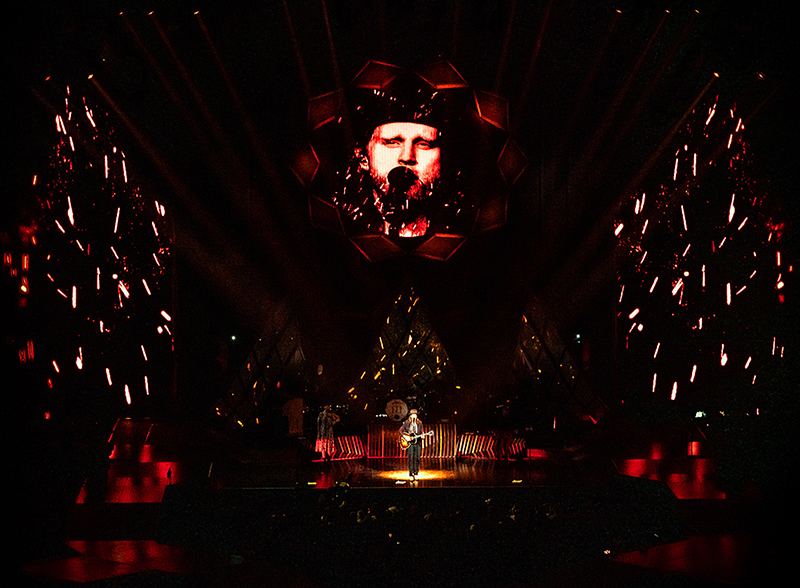
Video:
- 1 Grass Valley Karrera switcher
- 3 Grass Valley LDX86 long lens cameras
- 2 Grass Valley LDX86 handheld cameras
- 3 Panasonic Robotic Cameras w/ control
- 3 Marshall Mini Cameras
- 112 Saco S6mm modules used in the LED “Sun”
- 696 Saco S12mm modules used in the 2 side LED “windows”
- 3 Barco UDX Laser 32K projectors for scenic pieces on stage
- 4 Christie 20k Roadster projectors for side screens
- 2 21ft x 12ft fast fold screens
- 2 disguise GX2 media servers w/ Notch
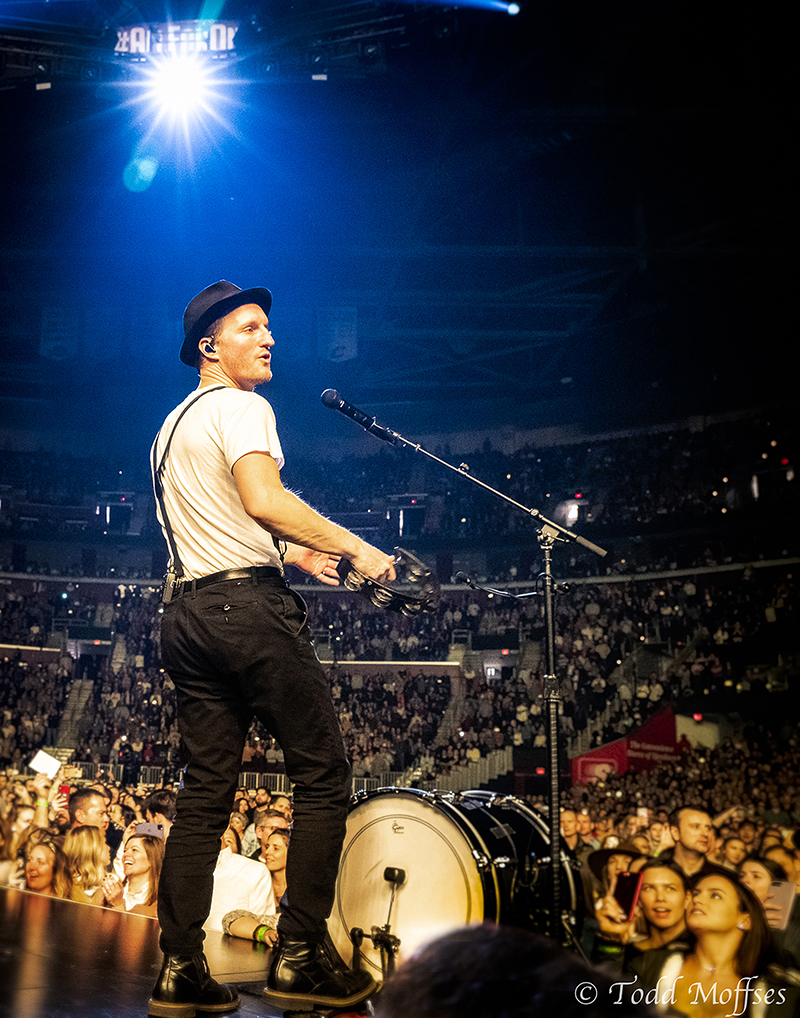
Rigging:
- 91 1-ton Liftket chain hoists
- 8 2-ton Liftket chain hoists
- 3 ½-ton Chain Master hoists
- 8 1/3-ton Liftket
- 4 Fall arrest system
